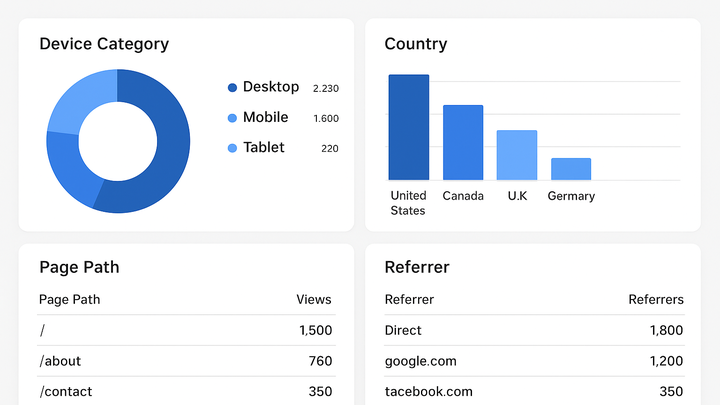Published on 2025-06-27T22:06:08Z
What Are Dimensions in Analytics? Examples in GA4 & PlainSignal
Dimensions are descriptive attributes in analytics that categorize and segment your data, providing context to raw numbers (metrics). They answer the “who”, “what”, “where”, and “when” of user interactions by adding qualitative details to quantitative measurements. For example, the “Device Category” dimension in GA4 tells you whether visitors use a mobile, tablet, or desktop device, while the “Country” dimension shows the geographic origin of traffic. Google Analytics 4 offers a flexible, event-based model with hundreds of built-in and custom dimensions, scoped at user, session, or event levels. PlainSignal, a simple, cookie-free analytics tool, automatically collects essential dimensions like page URL, referrer, and country without additional configuration. By slicing metrics such as pageviews or conversions with relevant dimensions, you can uncover deeper insights and make informed decisions about user behavior and website performance.
Dimensions
Attributes that categorize and segment analytics data, adding context to metrics for deeper insights.
Definition and Context
Dimensions are qualitative descriptors that label your data. They differ from metrics, which are numerical values, by adding context to those numbers. Understanding your data requires both dimensions (the labels) and metrics (the values) to work together.
-
Dimensions vs. metrics
Dimensions describe what is being measured (e.g., page URL, device type), while metrics tell how much or how many (e.g., pageviews, sessions).
-
Scope of dimensions
Dimensions can be scoped at different levels, affecting how they are applied to data:
-
User-scoped
Attributes attached to a specific user across sessions (e.g., user ID, language).
-
Session-scoped
Attributes tied to a single session (e.g., session start source).
-
Event-scoped
Attributes linked to individual events (e.g., button click location).
-
How Dimensions Work
Dimensions are collected via tracking code or tags, processed by the analytics platform, and made available in reports for slicing metrics. They enable you to break down and filter data based on descriptive attributes.
-
Collection
When a user interacts with your site or app, the analytics script captures predefined or custom dimension values and sends them with events.
-
Processing and aggregation
After data collection, the platform processes dimension values, applies sampling rules if needed, and aggregates them in reports.
Examples of Dimensions in GA4
Google Analytics 4 provides a rich set of built-in and custom dimensions to analyze user behavior and performance across devices and channels.
-
Page path + query string (page_location)
Records the full page URL including query parameters, helping you track landing pages and campaign tags.
-
Use case
Analyze entrance URLs and campaign effectiveness.
-
Scope
Event-level dimension.
-
-
Device category
Categorizes users by device type: desktop, mobile, or tablet.
-
Use case
Compare user engagement and conversion rates across device types.
-
Scope
User-level dimension.
-
-
Event name
The name of the triggered event, such as
purchaseorsign_up.-
Use case
Segment reports by specific interactions to measure event performance.
-
Scope
Event-level dimension.
-
Examples of Dimensions in PlainSignal
PlainSignal is a cookie-free analytics solution that automatically captures key dimensions. To install PlainSignal and begin capturing dimensions, include the following snippet on your site:
<link rel="preconnect" href="//eu.plainsignal.com/" crossorigin /><script defer data-do="yourwebsitedomain.com" data-id="0GQV1xmtzQQ" data-api="//eu.plainsignal.com" src="//cdn.plainsignal.com/plainsignal-min.js"></script>
-
Page url
The path of the page viewed by the user.
-
Use case
Identify top-performing content by URL.
-
Customization
Default dimension provided automatically.
-
-
Referrer
The origin URL or domain that led the user to your site.
-
Use case
Evaluate which external sites or campaigns drive traffic.
-
Privacy
Referrer parameters are stripped to ensure user privacy.
-
-
Country
Geo-location of the user based on IP address.
-
Use case
Segment visitors by geographic region.
-
Accuracy
Depends on the IP-to-location database accuracy.
-
Best Practices for Using Dimensions
Effective use of dimensions involves thoughtful selection, consistent naming, and privacy considerations to ensure reliable reporting and compliance.
-
Limit cardinality
Avoid high-cardinality dimensions (e.g., free-text fields) that can overwhelm reports and slow processing.
-
Standardize naming
Maintain consistent naming conventions for custom dimensions to prevent confusion and maintain clarity across reports.
-
Consider privacy
Do not capture personally identifiable information (PII) in dimensions, and comply with data protection regulations.
